Cost Analysis and Budgeting: Management Accounting Report
VerifiedAdded on 2020/01/28
|23
|5884
|67
Report
AI Summary
This report presents a comprehensive analysis of management accounting principles applied to a case study of Jeffrey and Son's, a manufacturing company producing the 'Exquisite' brand. The report begins by classifying different types of costs, calculating unit and total job costs using job costing, and determining the cost of 'Exquisite' using absorption costing. It includes detailed calculations and allocations of costs across various departments and activities. The report then analyzes a cost report for September, calculating variances and identifying areas for potential improvement using performance indicators. The report also explores budgeting processes, including the preparation of production, material purchase, material usage, and cash budgets. Finally, the report calculates variances, prepares a reconciliation operating statement, and offers findings to management based on identified responsibility centers. The report utilizes tables and working notes to support its findings and concludes with recommendations for cost reduction and performance enhancement within the organization.
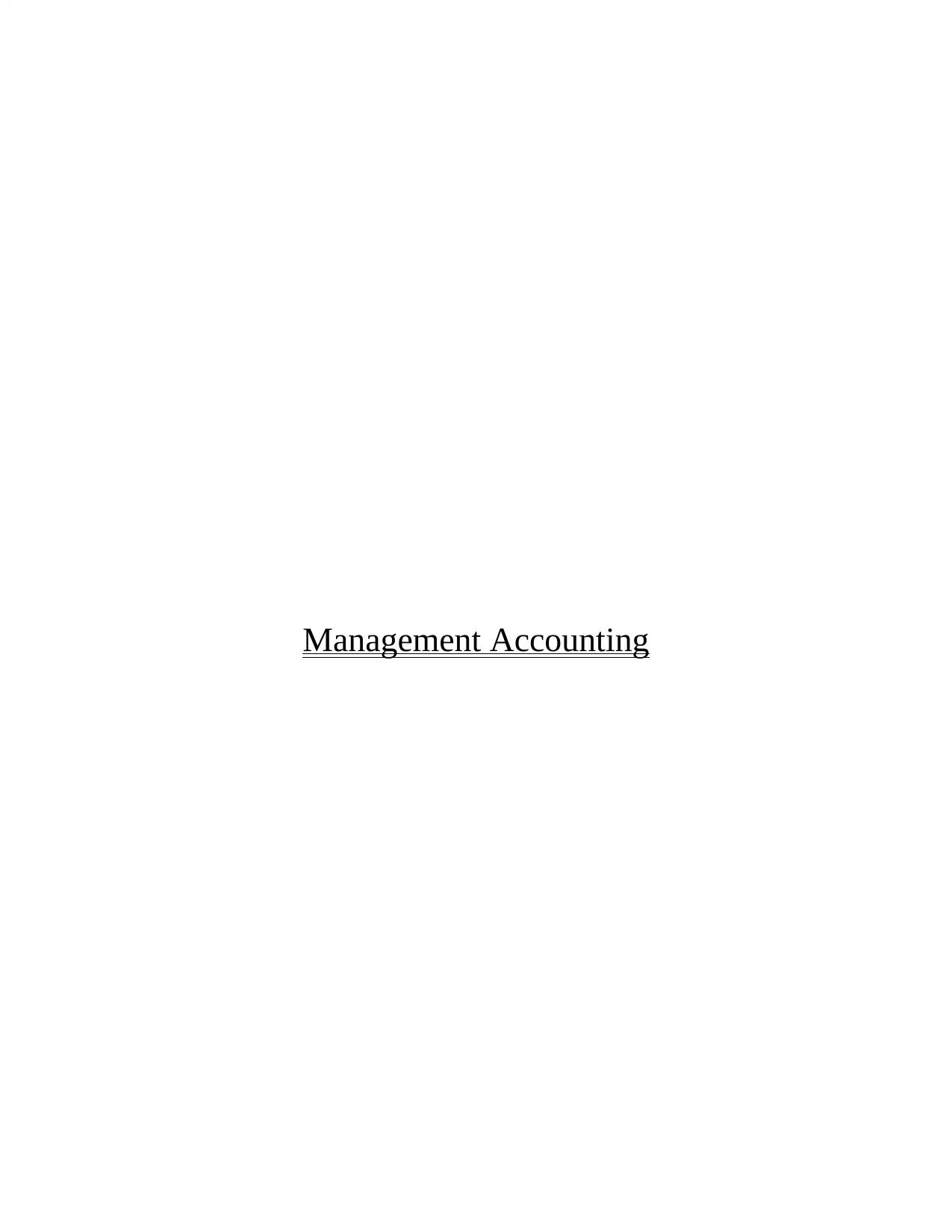
Management Accounting
Paraphrase This Document
Need a fresh take? Get an instant paraphrase of this document with our AI Paraphraser
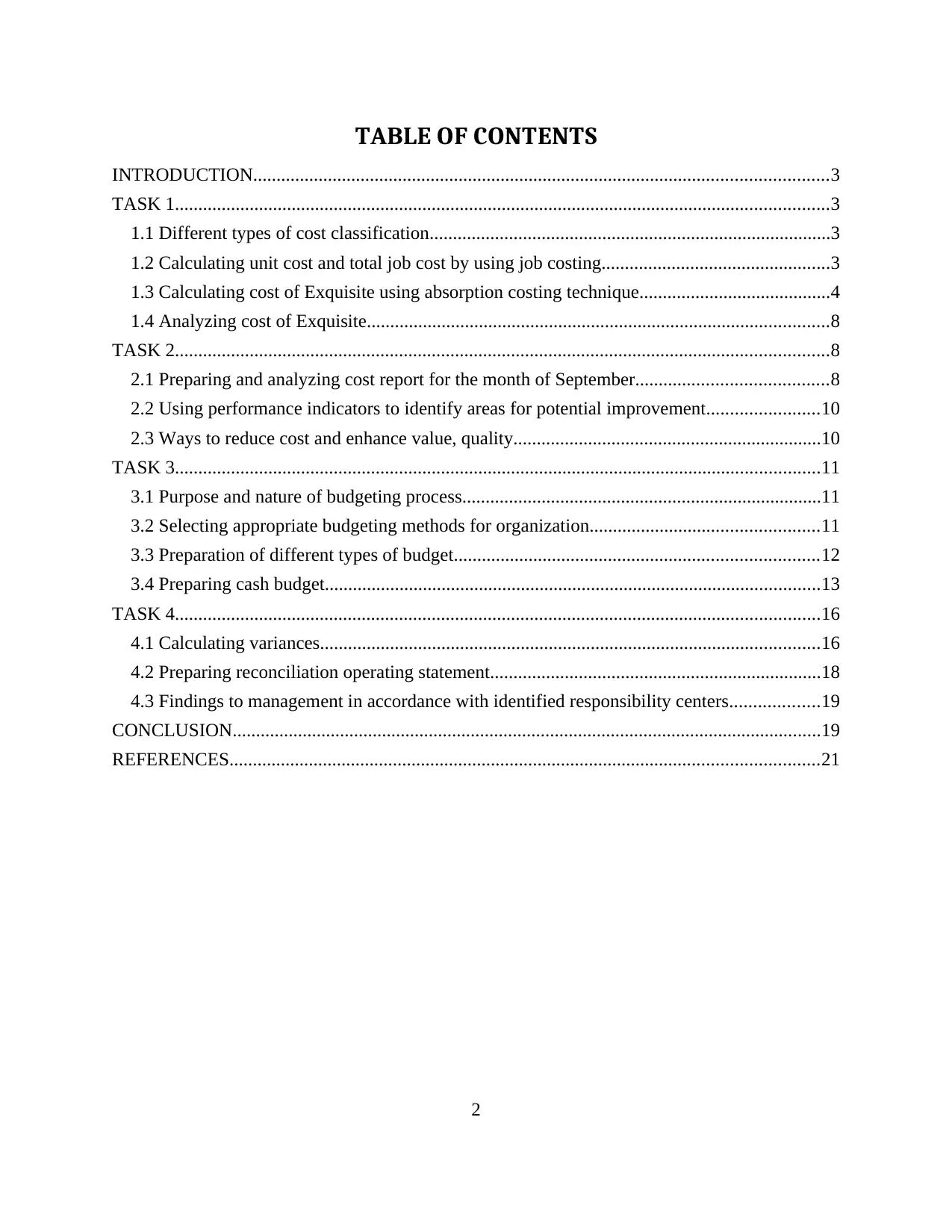
TABLE OF CONTENTS
INTRODUCTION...........................................................................................................................3
TASK 1............................................................................................................................................3
1.1 Different types of cost classification......................................................................................3
1.2 Calculating unit cost and total job cost by using job costing.................................................3
1.3 Calculating cost of Exquisite using absorption costing technique.........................................4
1.4 Analyzing cost of Exquisite...................................................................................................8
TASK 2............................................................................................................................................8
2.1 Preparing and analyzing cost report for the month of September.........................................8
2.2 Using performance indicators to identify areas for potential improvement........................10
2.3 Ways to reduce cost and enhance value, quality..................................................................10
TASK 3..........................................................................................................................................11
3.1 Purpose and nature of budgeting process.............................................................................11
3.2 Selecting appropriate budgeting methods for organization.................................................11
3.3 Preparation of different types of budget..............................................................................12
3.4 Preparing cash budget..........................................................................................................13
TASK 4..........................................................................................................................................16
4.1 Calculating variances...........................................................................................................16
4.2 Preparing reconciliation operating statement.......................................................................18
4.3 Findings to management in accordance with identified responsibility centers...................19
CONCLUSION..............................................................................................................................19
REFERENCES..............................................................................................................................21
2
INTRODUCTION...........................................................................................................................3
TASK 1............................................................................................................................................3
1.1 Different types of cost classification......................................................................................3
1.2 Calculating unit cost and total job cost by using job costing.................................................3
1.3 Calculating cost of Exquisite using absorption costing technique.........................................4
1.4 Analyzing cost of Exquisite...................................................................................................8
TASK 2............................................................................................................................................8
2.1 Preparing and analyzing cost report for the month of September.........................................8
2.2 Using performance indicators to identify areas for potential improvement........................10
2.3 Ways to reduce cost and enhance value, quality..................................................................10
TASK 3..........................................................................................................................................11
3.1 Purpose and nature of budgeting process.............................................................................11
3.2 Selecting appropriate budgeting methods for organization.................................................11
3.3 Preparation of different types of budget..............................................................................12
3.4 Preparing cash budget..........................................................................................................13
TASK 4..........................................................................................................................................16
4.1 Calculating variances...........................................................................................................16
4.2 Preparing reconciliation operating statement.......................................................................18
4.3 Findings to management in accordance with identified responsibility centers...................19
CONCLUSION..............................................................................................................................19
REFERENCES..............................................................................................................................21
2
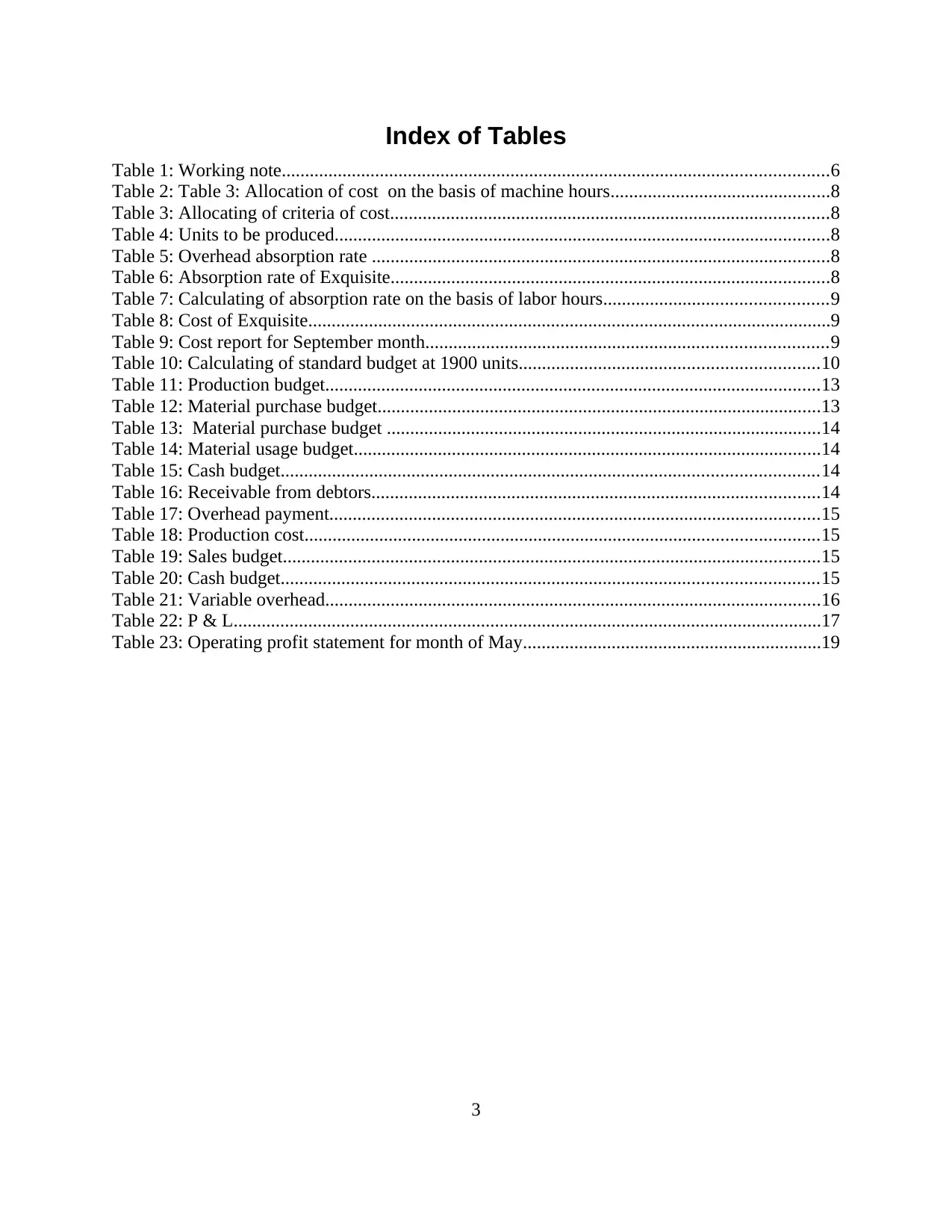
Index of Tables
Table 1: Working note.....................................................................................................................6
Table 2: Table 3: Allocation of cost on the basis of machine hours...............................................8
Table 3: Allocating of criteria of cost..............................................................................................8
Table 4: Units to be produced..........................................................................................................8
Table 5: Overhead absorption rate ..................................................................................................8
Table 6: Absorption rate of Exquisite..............................................................................................8
Table 7: Calculating of absorption rate on the basis of labor hours................................................9
Table 8: Cost of Exquisite................................................................................................................9
Table 9: Cost report for September month......................................................................................9
Table 10: Calculating of standard budget at 1900 units................................................................10
Table 11: Production budget..........................................................................................................13
Table 12: Material purchase budget...............................................................................................13
Table 13: Material purchase budget .............................................................................................14
Table 14: Material usage budget....................................................................................................14
Table 15: Cash budget...................................................................................................................14
Table 16: Receivable from debtors................................................................................................14
Table 17: Overhead payment.........................................................................................................15
Table 18: Production cost..............................................................................................................15
Table 19: Sales budget...................................................................................................................15
Table 20: Cash budget...................................................................................................................15
Table 21: Variable overhead..........................................................................................................16
Table 22: P & L..............................................................................................................................17
Table 23: Operating profit statement for month of May................................................................19
3
Table 1: Working note.....................................................................................................................6
Table 2: Table 3: Allocation of cost on the basis of machine hours...............................................8
Table 3: Allocating of criteria of cost..............................................................................................8
Table 4: Units to be produced..........................................................................................................8
Table 5: Overhead absorption rate ..................................................................................................8
Table 6: Absorption rate of Exquisite..............................................................................................8
Table 7: Calculating of absorption rate on the basis of labor hours................................................9
Table 8: Cost of Exquisite................................................................................................................9
Table 9: Cost report for September month......................................................................................9
Table 10: Calculating of standard budget at 1900 units................................................................10
Table 11: Production budget..........................................................................................................13
Table 12: Material purchase budget...............................................................................................13
Table 13: Material purchase budget .............................................................................................14
Table 14: Material usage budget....................................................................................................14
Table 15: Cash budget...................................................................................................................14
Table 16: Receivable from debtors................................................................................................14
Table 17: Overhead payment.........................................................................................................15
Table 18: Production cost..............................................................................................................15
Table 19: Sales budget...................................................................................................................15
Table 20: Cash budget...................................................................................................................15
Table 21: Variable overhead..........................................................................................................16
Table 22: P & L..............................................................................................................................17
Table 23: Operating profit statement for month of May................................................................19
3
⊘ This is a preview!⊘
Do you want full access?
Subscribe today to unlock all pages.

Trusted by 1+ million students worldwide
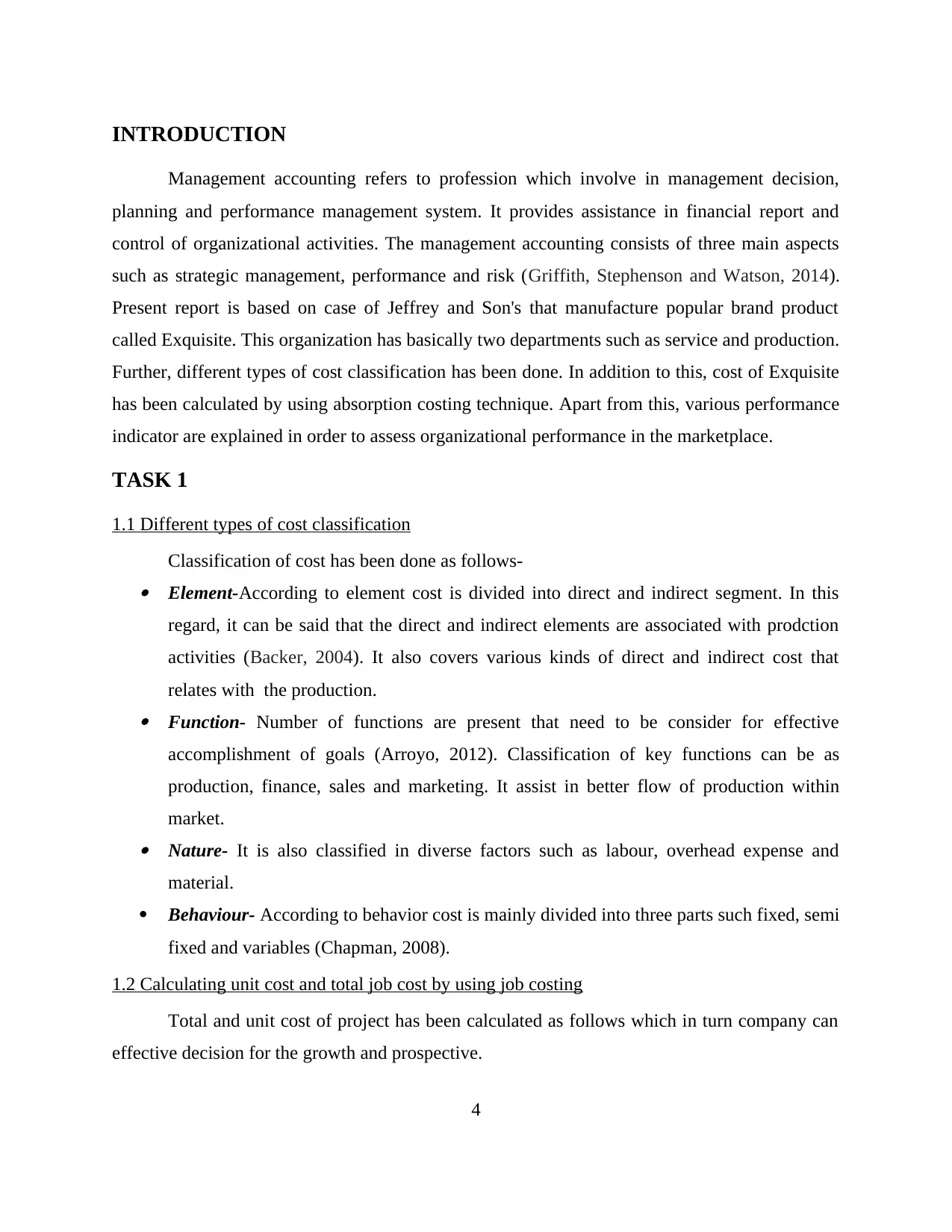
INTRODUCTION
Management accounting refers to profession which involve in management decision,
planning and performance management system. It provides assistance in financial report and
control of organizational activities. The management accounting consists of three main aspects
such as strategic management, performance and risk (Griffith, Stephenson and Watson, 2014).
Present report is based on case of Jeffrey and Son's that manufacture popular brand product
called Exquisite. This organization has basically two departments such as service and production.
Further, different types of cost classification has been done. In addition to this, cost of Exquisite
has been calculated by using absorption costing technique. Apart from this, various performance
indicator are explained in order to assess organizational performance in the marketplace.
TASK 1
1.1 Different types of cost classification
Classification of cost has been done as follows- Element-According to element cost is divided into direct and indirect segment. In this
regard, it can be said that the direct and indirect elements are associated with prodction
activities (Backer, 2004). It also covers various kinds of direct and indirect cost that
relates with the production. Function- Number of functions are present that need to be consider for effective
accomplishment of goals (Arroyo, 2012). Classification of key functions can be as
production, finance, sales and marketing. It assist in better flow of production within
market. Nature- It is also classified in diverse factors such as labour, overhead expense and
material.
Behaviour- According to behavior cost is mainly divided into three parts such fixed, semi
fixed and variables (Chapman, 2008).
1.2 Calculating unit cost and total job cost by using job costing
Total and unit cost of project has been calculated as follows which in turn company can
effective decision for the growth and prospective.
4
Management accounting refers to profession which involve in management decision,
planning and performance management system. It provides assistance in financial report and
control of organizational activities. The management accounting consists of three main aspects
such as strategic management, performance and risk (Griffith, Stephenson and Watson, 2014).
Present report is based on case of Jeffrey and Son's that manufacture popular brand product
called Exquisite. This organization has basically two departments such as service and production.
Further, different types of cost classification has been done. In addition to this, cost of Exquisite
has been calculated by using absorption costing technique. Apart from this, various performance
indicator are explained in order to assess organizational performance in the marketplace.
TASK 1
1.1 Different types of cost classification
Classification of cost has been done as follows- Element-According to element cost is divided into direct and indirect segment. In this
regard, it can be said that the direct and indirect elements are associated with prodction
activities (Backer, 2004). It also covers various kinds of direct and indirect cost that
relates with the production. Function- Number of functions are present that need to be consider for effective
accomplishment of goals (Arroyo, 2012). Classification of key functions can be as
production, finance, sales and marketing. It assist in better flow of production within
market. Nature- It is also classified in diverse factors such as labour, overhead expense and
material.
Behaviour- According to behavior cost is mainly divided into three parts such fixed, semi
fixed and variables (Chapman, 2008).
1.2 Calculating unit cost and total job cost by using job costing
Total and unit cost of project has been calculated as follows which in turn company can
effective decision for the growth and prospective.
4
Paraphrase This Document
Need a fresh take? Get an instant paraphrase of this document with our AI Paraphraser
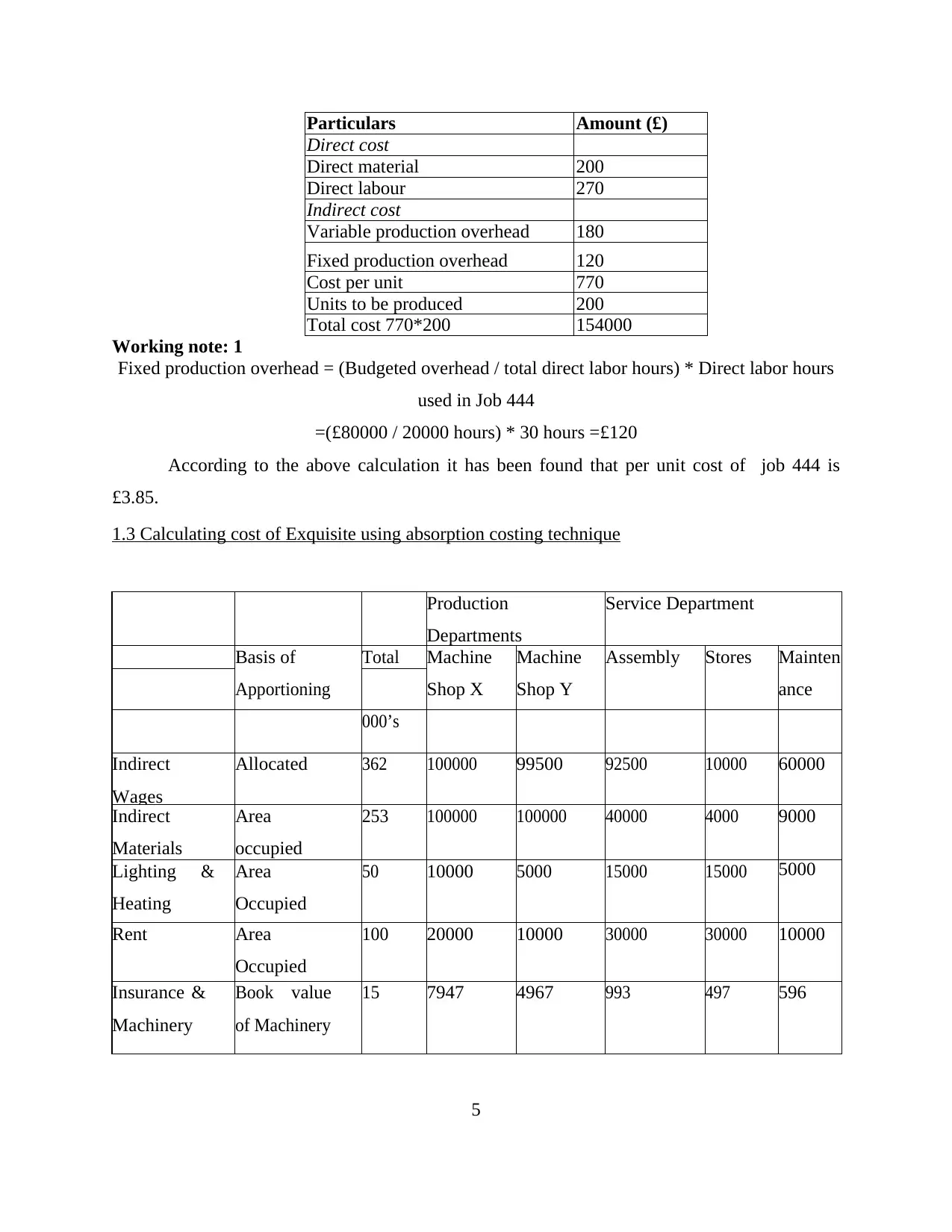
Particulars Amount (£)
Direct cost
Direct material 200
Direct labour 270
Indirect cost
Variable production overhead 180
Fixed production overhead 120
Cost per unit 770
Units to be produced 200
Total cost 770*200 154000
Working note: 1
Fixed production overhead = (Budgeted overhead / total direct labor hours) * Direct labor hours
used in Job 444
=(£80000 / 20000 hours) * 30 hours =£120
According to the above calculation it has been found that per unit cost of job 444 is
£3.85.
1.3 Calculating cost of Exquisite using absorption costing technique
Production
Departments
Service Department
Basis of
Apportioning
Total Machine
Shop X
Machine
Shop Y
Assembly Stores Mainten
ance
000’s
Indirect
Wages
Allocated 362 100000 99500 92500 10000 60000
Indirect
Materials
Area
occupied
253 100000 100000 40000 4000 9000
Lighting
Heating
& Area
Occupied
50 10000 5000 15000 15000 5000
Rent Area
Occupied
100 20000 10000 30000 30000 10000
Insurance &
Machinery
Book value
of Machinery
15 7947 4967 993 497 596
5
Direct cost
Direct material 200
Direct labour 270
Indirect cost
Variable production overhead 180
Fixed production overhead 120
Cost per unit 770
Units to be produced 200
Total cost 770*200 154000
Working note: 1
Fixed production overhead = (Budgeted overhead / total direct labor hours) * Direct labor hours
used in Job 444
=(£80000 / 20000 hours) * 30 hours =£120
According to the above calculation it has been found that per unit cost of job 444 is
£3.85.
1.3 Calculating cost of Exquisite using absorption costing technique
Production
Departments
Service Department
Basis of
Apportioning
Total Machine
Shop X
Machine
Shop Y
Assembly Stores Mainten
ance
000’s
Indirect
Wages
Allocated 362 100000 99500 92500 10000 60000
Indirect
Materials
Area
occupied
253 100000 100000 40000 4000 9000
Lighting
Heating
& Area
Occupied
50 10000 5000 15000 15000 5000
Rent Area
Occupied
100 20000 10000 30000 30000 10000
Insurance &
Machinery
Book value
of Machinery
15 7947 4967 993 497 596
5
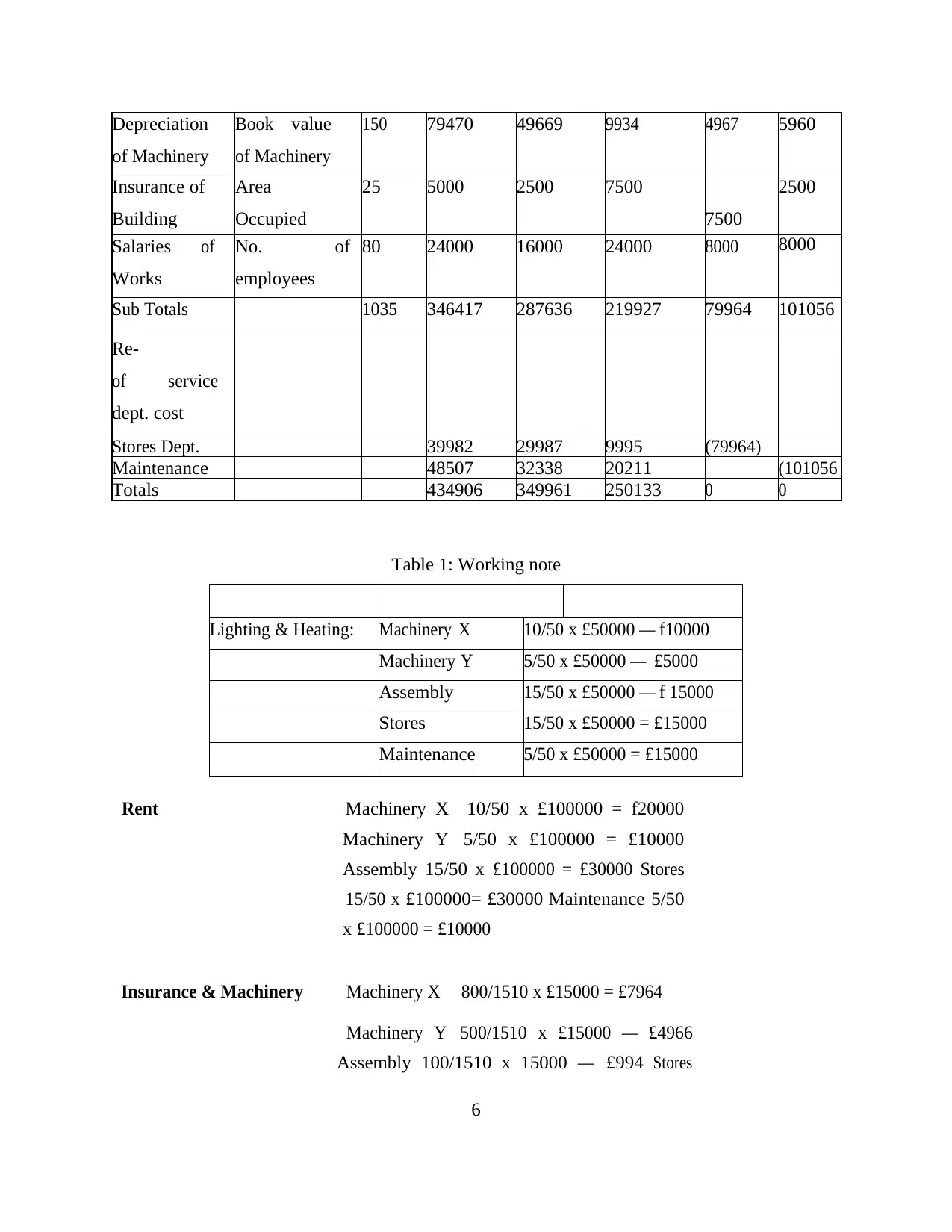
Depreciation
of Machinery
Book value
of Machinery
150 79470 49669 9934 4967 5960
Insurance of
Building
Area
Occupied
25 5000 2500 7500
7500
2500
Salaries
Works
of No.
employees
of 80 24000 16000 24000 8000 8000
Sub Totals 1035 346417 287636 219927 79964 101056
Re-
of service
dept. cost
Stores Dept. 39982 29987 9995 (79964)
Maintenance 48507 32338 20211 (101056
Totals 434906 349961 250133 0 0
Table 1: Working note
Lighting & Heating: Machinery X 10/50 x £50000 — f10000
Machinery Y 5/50 x £50000 — £5000
Assembly 15/50 x £50000 — f 15000
Stores 15/50 x £50000 = £15000
Maintenance 5/50 x £50000 = £15000
Rent Machinery X 10/50 x £100000 = f20000
Machinery Y 5/50 x £100000 = £10000
Assembly 15/50 x £100000 = £30000 Stores
15/50 x £100000= £30000 Maintenance 5/50
x £100000 = £10000
Insurance & Machinery Machinery X 800/1510 x £15000 = £7964
Machinery Y 500/1510 x £15000 — £4966
Assembly 100/1510 x 15000 — £994 Stores
6
of Machinery
Book value
of Machinery
150 79470 49669 9934 4967 5960
Insurance of
Building
Area
Occupied
25 5000 2500 7500
7500
2500
Salaries
Works
of No.
employees
of 80 24000 16000 24000 8000 8000
Sub Totals 1035 346417 287636 219927 79964 101056
Re-
of service
dept. cost
Stores Dept. 39982 29987 9995 (79964)
Maintenance 48507 32338 20211 (101056
Totals 434906 349961 250133 0 0
Table 1: Working note
Lighting & Heating: Machinery X 10/50 x £50000 — f10000
Machinery Y 5/50 x £50000 — £5000
Assembly 15/50 x £50000 — f 15000
Stores 15/50 x £50000 = £15000
Maintenance 5/50 x £50000 = £15000
Rent Machinery X 10/50 x £100000 = f20000
Machinery Y 5/50 x £100000 = £10000
Assembly 15/50 x £100000 = £30000 Stores
15/50 x £100000= £30000 Maintenance 5/50
x £100000 = £10000
Insurance & Machinery Machinery X 800/1510 x £15000 = £7964
Machinery Y 500/1510 x £15000 — £4966
Assembly 100/1510 x 15000 — £994 Stores
6
⊘ This is a preview!⊘
Do you want full access?
Subscribe today to unlock all pages.

Trusted by 1+ million students worldwide
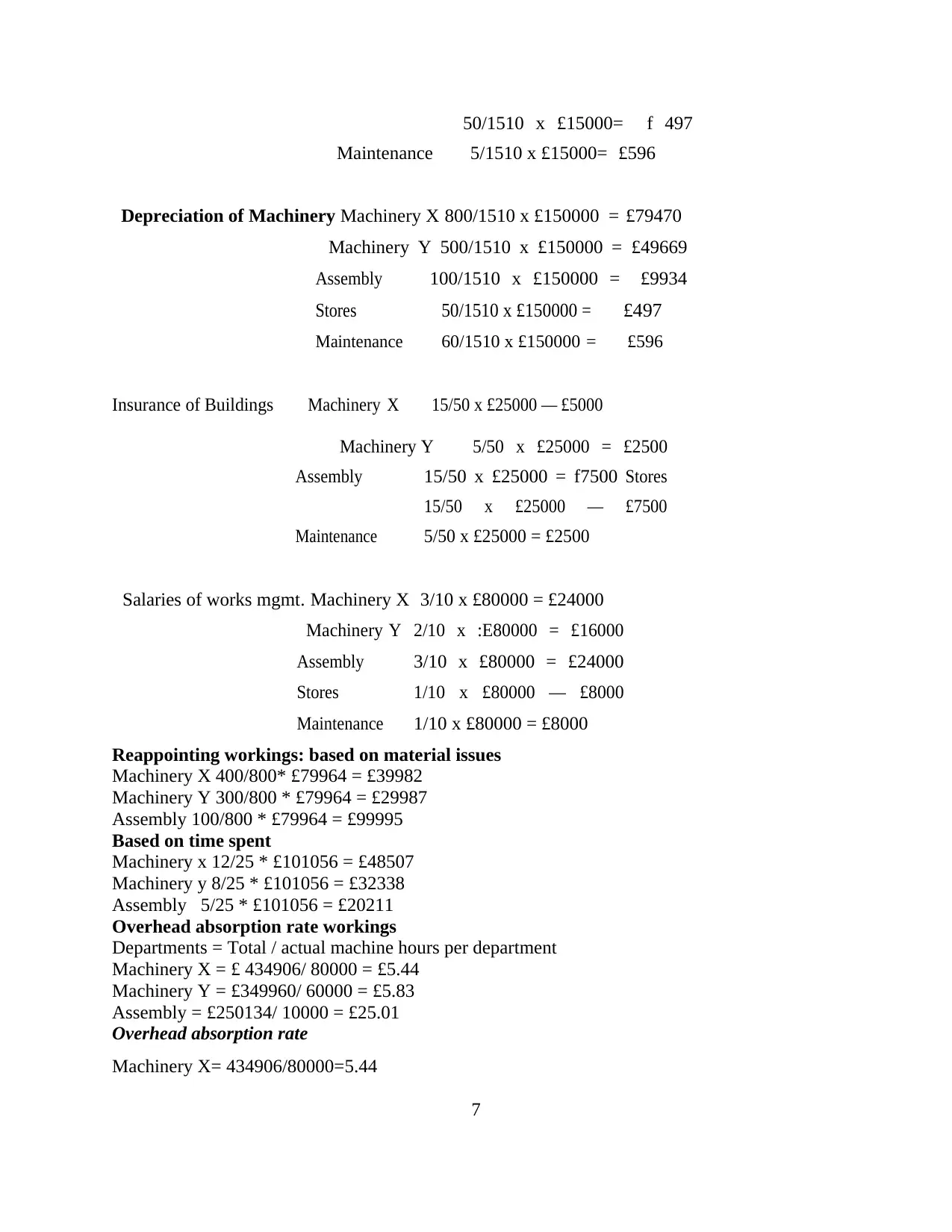
50/1510 x £15000= f 497
Maintenance 5/1510 x £15000= £596
Depreciation of Machinery Machinery X 800/1510 x £150000 = £79470
Machinery Y 500/1510 x £150000 = £49669
Assembly 100/1510 x £150000 = £9934
Stores 50/1510 x £150000 = £497
Maintenance 60/1510 x £150000 = £596
Insurance of Buildings Machinery X 15/50 x £25000 — £5000
Machinery Y 5/50 x £25000 = £2500
Assembly 15/50 x £25000 = f7500 Stores
15/50 x £25000 — £7500
Maintenance 5/50 x £25000 = £2500
Salaries of works mgmt. Machinery X 3/10 x £80000 = £24000
Machinery Y 2/10 x :E80000 = £16000
Assembly 3/10 x £80000 = £24000
Stores 1/10 x £80000 — £8000
Maintenance 1/10 x £80000 = £8000
Reappointing workings: based on material issues
Machinery X 400/800* £79964 = £39982
Machinery Y 300/800 * £79964 = £29987
Assembly 100/800 * £79964 = £99995
Based on time spent
Machinery x 12/25 * £101056 = £48507
Machinery y 8/25 * £101056 = £32338
Assembly 5/25 * £101056 = £20211
Overhead absorption rate workings
Departments = Total / actual machine hours per department
Machinery X = £ 434906/ 80000 = £5.44
Machinery Y = £349960/ 60000 = £5.83
Assembly = £250134/ 10000 = £25.01
Overhead absorption rate
Machinery X= 434906/80000=5.44
7
Maintenance 5/1510 x £15000= £596
Depreciation of Machinery Machinery X 800/1510 x £150000 = £79470
Machinery Y 500/1510 x £150000 = £49669
Assembly 100/1510 x £150000 = £9934
Stores 50/1510 x £150000 = £497
Maintenance 60/1510 x £150000 = £596
Insurance of Buildings Machinery X 15/50 x £25000 — £5000
Machinery Y 5/50 x £25000 = £2500
Assembly 15/50 x £25000 = f7500 Stores
15/50 x £25000 — £7500
Maintenance 5/50 x £25000 = £2500
Salaries of works mgmt. Machinery X 3/10 x £80000 = £24000
Machinery Y 2/10 x :E80000 = £16000
Assembly 3/10 x £80000 = £24000
Stores 1/10 x £80000 — £8000
Maintenance 1/10 x £80000 = £8000
Reappointing workings: based on material issues
Machinery X 400/800* £79964 = £39982
Machinery Y 300/800 * £79964 = £29987
Assembly 100/800 * £79964 = £99995
Based on time spent
Machinery x 12/25 * £101056 = £48507
Machinery y 8/25 * £101056 = £32338
Assembly 5/25 * £101056 = £20211
Overhead absorption rate workings
Departments = Total / actual machine hours per department
Machinery X = £ 434906/ 80000 = £5.44
Machinery Y = £349960/ 60000 = £5.83
Assembly = £250134/ 10000 = £25.01
Overhead absorption rate
Machinery X= 434906/80000=5.44
7
Paraphrase This Document
Need a fresh take? Get an instant paraphrase of this document with our AI Paraphraser
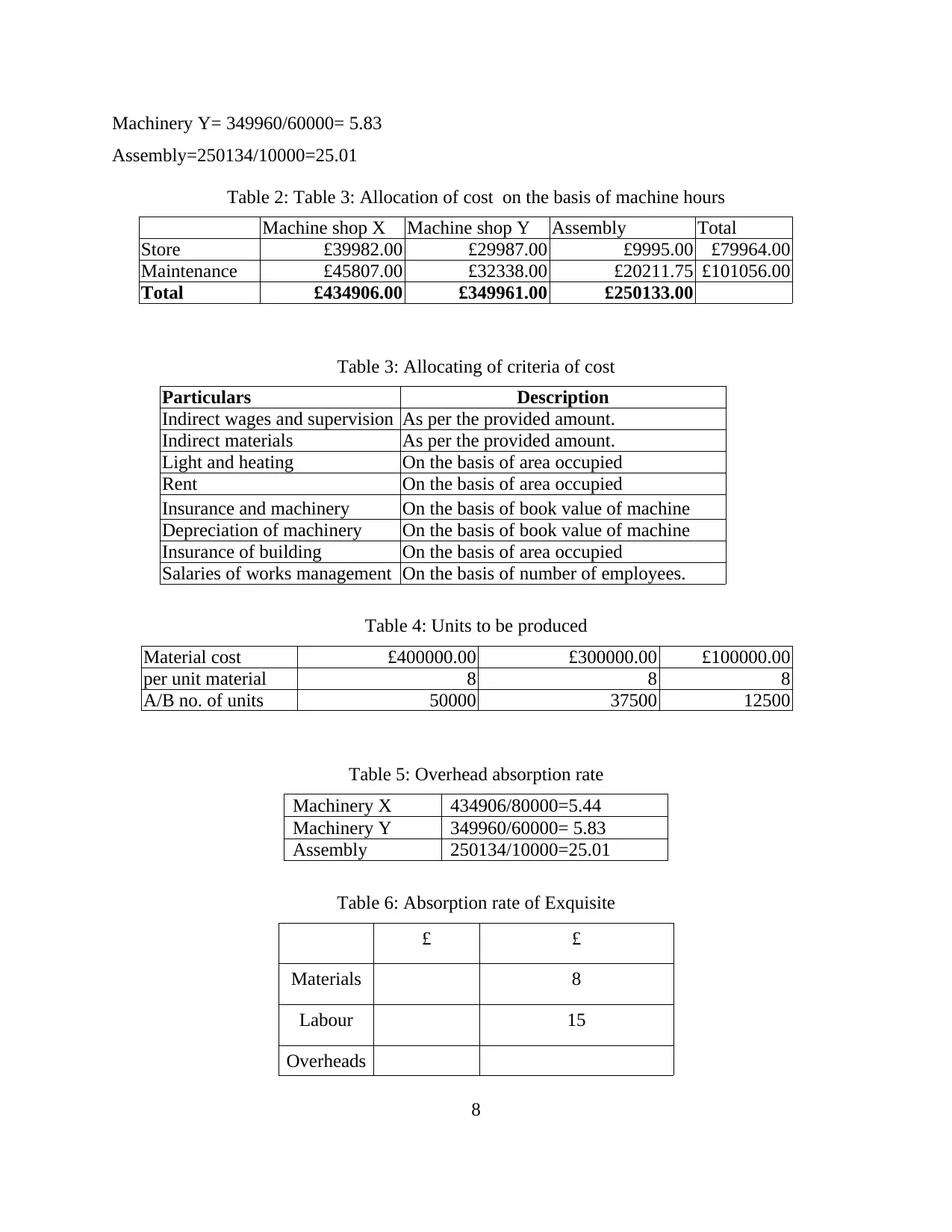
Machinery Y= 349960/60000= 5.83
Assembly=250134/10000=25.01
Table 2: Table 3: Allocation of cost on the basis of machine hours
Machine shop X Machine shop Y Assembly Total
Store £39982.00 £29987.00 £9995.00 £79964.00
Maintenance £45807.00 £32338.00 £20211.75 £101056.00
Total £434906.00 £349961.00 £250133.00
Table 3: Allocating of criteria of cost
Particulars Description
Indirect wages and supervision As per the provided amount.
Indirect materials As per the provided amount.
Light and heating On the basis of area occupied
Rent On the basis of area occupied
Insurance and machinery On the basis of book value of machine
Depreciation of machinery On the basis of book value of machine
Insurance of building On the basis of area occupied
Salaries of works management On the basis of number of employees.
Table 4: Units to be produced
Material cost £400000.00 £300000.00 £100000.00
per unit material 8 8 8
A/B no. of units 50000 37500 12500
Table 5: Overhead absorption rate
Machinery X 434906/80000=5.44
Machinery Y 349960/60000= 5.83
Assembly 250134/10000=25.01
Table 6: Absorption rate of Exquisite
£ £
Materials 8
Labour 15
Overheads
8
Assembly=250134/10000=25.01
Table 2: Table 3: Allocation of cost on the basis of machine hours
Machine shop X Machine shop Y Assembly Total
Store £39982.00 £29987.00 £9995.00 £79964.00
Maintenance £45807.00 £32338.00 £20211.75 £101056.00
Total £434906.00 £349961.00 £250133.00
Table 3: Allocating of criteria of cost
Particulars Description
Indirect wages and supervision As per the provided amount.
Indirect materials As per the provided amount.
Light and heating On the basis of area occupied
Rent On the basis of area occupied
Insurance and machinery On the basis of book value of machine
Depreciation of machinery On the basis of book value of machine
Insurance of building On the basis of area occupied
Salaries of works management On the basis of number of employees.
Table 4: Units to be produced
Material cost £400000.00 £300000.00 £100000.00
per unit material 8 8 8
A/B no. of units 50000 37500 12500
Table 5: Overhead absorption rate
Machinery X 434906/80000=5.44
Machinery Y 349960/60000= 5.83
Assembly 250134/10000=25.01
Table 6: Absorption rate of Exquisite
£ £
Materials 8
Labour 15
Overheads
8
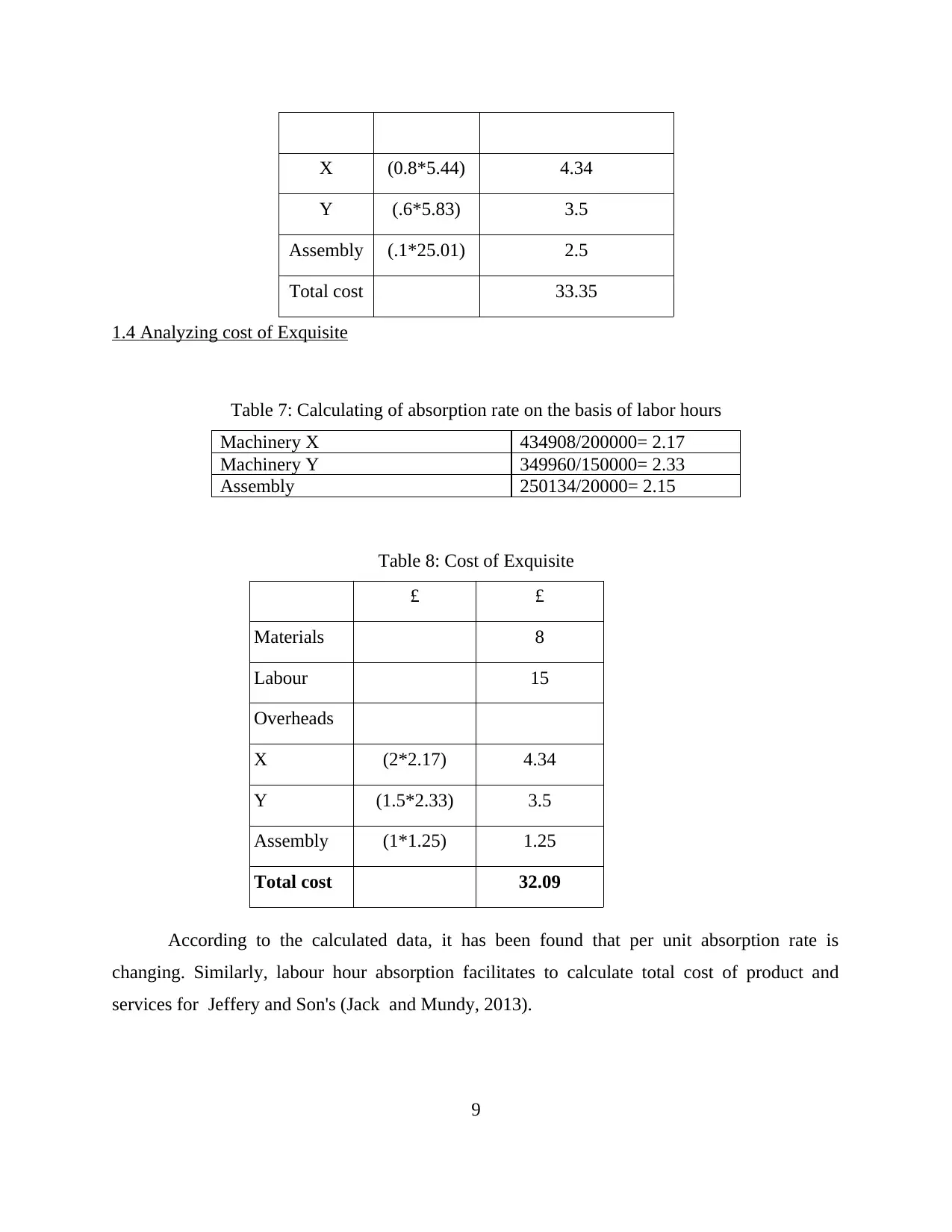
X (0.8*5.44) 4.34
Y (.6*5.83) 3.5
Assembly (.1*25.01) 2.5
Total cost 33.35
1.4 Analyzing cost of Exquisite
Table 7: Calculating of absorption rate on the basis of labor hours
Machinery X 434908/200000= 2.17
Machinery Y 349960/150000= 2.33
Assembly 250134/20000= 2.15
Table 8: Cost of Exquisite
£ £
Materials 8
Labour 15
Overheads
X (2*2.17) 4.34
Y (1.5*2.33) 3.5
Assembly (1*1.25) 1.25
Total cost 32.09
According to the calculated data, it has been found that per unit absorption rate is
changing. Similarly, labour hour absorption facilitates to calculate total cost of product and
services for Jeffery and Son's (Jack and Mundy, 2013).
9
Y (.6*5.83) 3.5
Assembly (.1*25.01) 2.5
Total cost 33.35
1.4 Analyzing cost of Exquisite
Table 7: Calculating of absorption rate on the basis of labor hours
Machinery X 434908/200000= 2.17
Machinery Y 349960/150000= 2.33
Assembly 250134/20000= 2.15
Table 8: Cost of Exquisite
£ £
Materials 8
Labour 15
Overheads
X (2*2.17) 4.34
Y (1.5*2.33) 3.5
Assembly (1*1.25) 1.25
Total cost 32.09
According to the calculated data, it has been found that per unit absorption rate is
changing. Similarly, labour hour absorption facilitates to calculate total cost of product and
services for Jeffery and Son's (Jack and Mundy, 2013).
9
⊘ This is a preview!⊘
Do you want full access?
Subscribe today to unlock all pages.

Trusted by 1+ million students worldwide
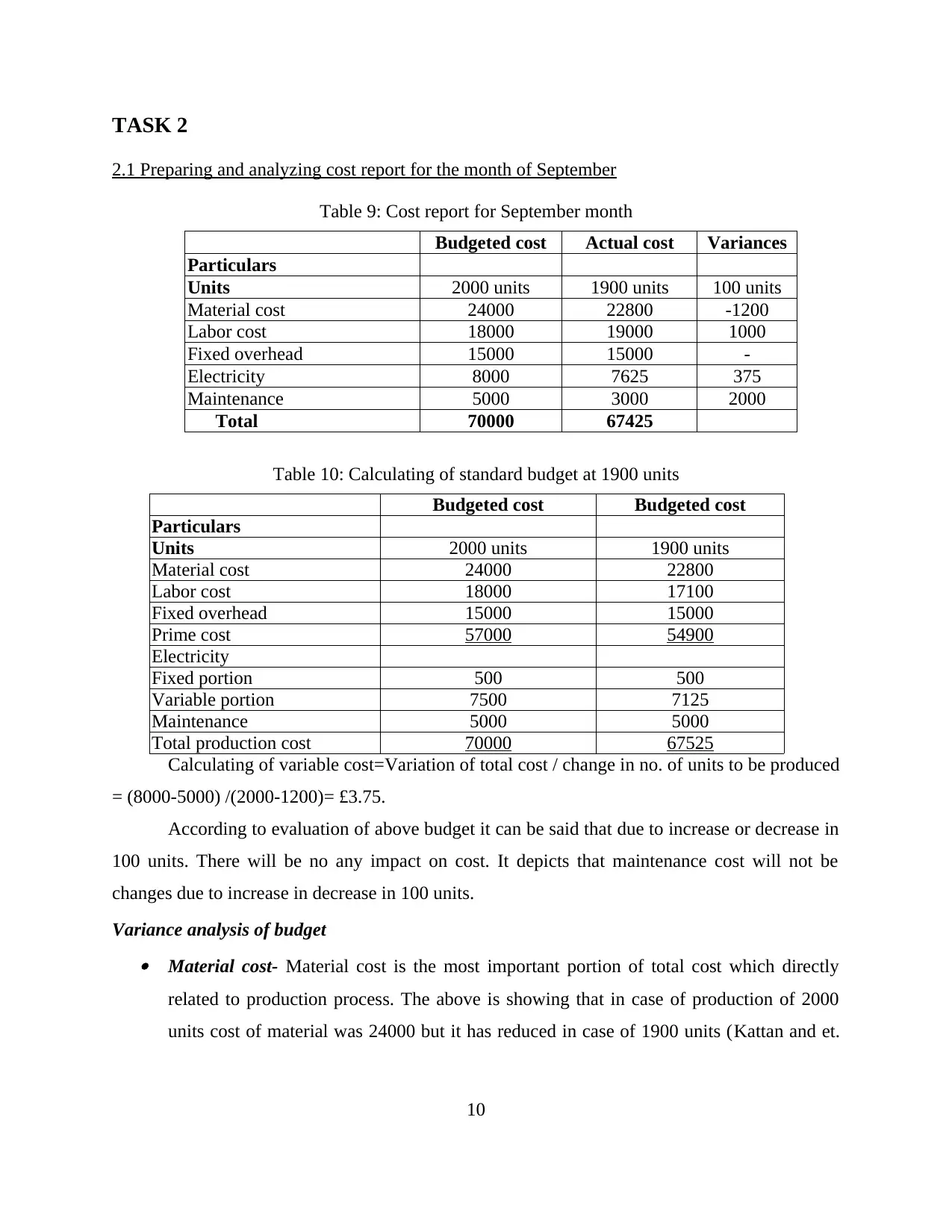
TASK 2
2.1 Preparing and analyzing cost report for the month of September
Table 9: Cost report for September month
Budgeted cost Actual cost Variances
Particulars
Units 2000 units 1900 units 100 units
Material cost 24000 22800 -1200
Labor cost 18000 19000 1000
Fixed overhead 15000 15000 -
Electricity 8000 7625 375
Maintenance 5000 3000 2000
Total 70000 67425
Table 10: Calculating of standard budget at 1900 units
Budgeted cost Budgeted cost
Particulars
Units 2000 units 1900 units
Material cost 24000 22800
Labor cost 18000 17100
Fixed overhead 15000 15000
Prime cost 57000 54900
Electricity
Fixed portion 500 500
Variable portion 7500 7125
Maintenance 5000 5000
Total production cost 70000 67525
Calculating of variable cost=Variation of total cost / change in no. of units to be produced
= (8000-5000) /(2000-1200)= £3.75.
According to evaluation of above budget it can be said that due to increase or decrease in
100 units. There will be no any impact on cost. It depicts that maintenance cost will not be
changes due to increase in decrease in 100 units.
Variance analysis of budget Material cost- Material cost is the most important portion of total cost which directly
related to production process. The above is showing that in case of production of 2000
units cost of material was 24000 but it has reduced in case of 1900 units (Kattan and et.
10
2.1 Preparing and analyzing cost report for the month of September
Table 9: Cost report for September month
Budgeted cost Actual cost Variances
Particulars
Units 2000 units 1900 units 100 units
Material cost 24000 22800 -1200
Labor cost 18000 19000 1000
Fixed overhead 15000 15000 -
Electricity 8000 7625 375
Maintenance 5000 3000 2000
Total 70000 67425
Table 10: Calculating of standard budget at 1900 units
Budgeted cost Budgeted cost
Particulars
Units 2000 units 1900 units
Material cost 24000 22800
Labor cost 18000 17100
Fixed overhead 15000 15000
Prime cost 57000 54900
Electricity
Fixed portion 500 500
Variable portion 7500 7125
Maintenance 5000 5000
Total production cost 70000 67525
Calculating of variable cost=Variation of total cost / change in no. of units to be produced
= (8000-5000) /(2000-1200)= £3.75.
According to evaluation of above budget it can be said that due to increase or decrease in
100 units. There will be no any impact on cost. It depicts that maintenance cost will not be
changes due to increase in decrease in 100 units.
Variance analysis of budget Material cost- Material cost is the most important portion of total cost which directly
related to production process. The above is showing that in case of production of 2000
units cost of material was 24000 but it has reduced in case of 1900 units (Kattan and et.
10
Paraphrase This Document
Need a fresh take? Get an instant paraphrase of this document with our AI Paraphraser
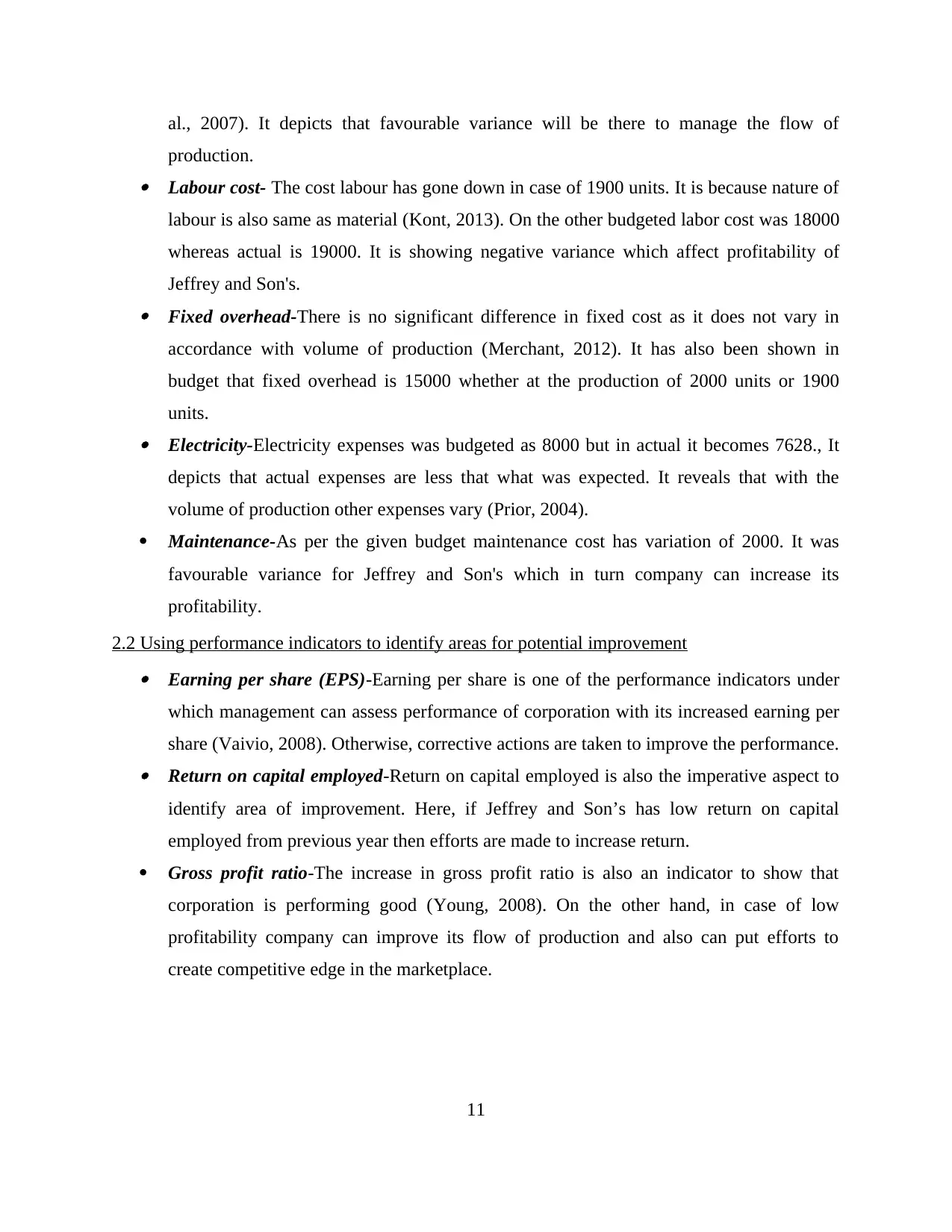
al., 2007). It depicts that favourable variance will be there to manage the flow of
production. Labour cost- The cost labour has gone down in case of 1900 units. It is because nature of
labour is also same as material (Kont, 2013). On the other budgeted labor cost was 18000
whereas actual is 19000. It is showing negative variance which affect profitability of
Jeffrey and Son's. Fixed overhead-There is no significant difference in fixed cost as it does not vary in
accordance with volume of production (Merchant, 2012). It has also been shown in
budget that fixed overhead is 15000 whether at the production of 2000 units or 1900
units. Electricity-Electricity expenses was budgeted as 8000 but in actual it becomes 7628., It
depicts that actual expenses are less that what was expected. It reveals that with the
volume of production other expenses vary (Prior, 2004).
Maintenance-As per the given budget maintenance cost has variation of 2000. It was
favourable variance for Jeffrey and Son's which in turn company can increase its
profitability.
2.2 Using performance indicators to identify areas for potential improvement Earning per share (EPS)-Earning per share is one of the performance indicators under
which management can assess performance of corporation with its increased earning per
share (Vaivio, 2008). Otherwise, corrective actions are taken to improve the performance. Return on capital employed-Return on capital employed is also the imperative aspect to
identify area of improvement. Here, if Jeffrey and Son’s has low return on capital
employed from previous year then efforts are made to increase return.
Gross profit ratio-The increase in gross profit ratio is also an indicator to show that
corporation is performing good (Young, 2008). On the other hand, in case of low
profitability company can improve its flow of production and also can put efforts to
create competitive edge in the marketplace.
11
production. Labour cost- The cost labour has gone down in case of 1900 units. It is because nature of
labour is also same as material (Kont, 2013). On the other budgeted labor cost was 18000
whereas actual is 19000. It is showing negative variance which affect profitability of
Jeffrey and Son's. Fixed overhead-There is no significant difference in fixed cost as it does not vary in
accordance with volume of production (Merchant, 2012). It has also been shown in
budget that fixed overhead is 15000 whether at the production of 2000 units or 1900
units. Electricity-Electricity expenses was budgeted as 8000 but in actual it becomes 7628., It
depicts that actual expenses are less that what was expected. It reveals that with the
volume of production other expenses vary (Prior, 2004).
Maintenance-As per the given budget maintenance cost has variation of 2000. It was
favourable variance for Jeffrey and Son's which in turn company can increase its
profitability.
2.2 Using performance indicators to identify areas for potential improvement Earning per share (EPS)-Earning per share is one of the performance indicators under
which management can assess performance of corporation with its increased earning per
share (Vaivio, 2008). Otherwise, corrective actions are taken to improve the performance. Return on capital employed-Return on capital employed is also the imperative aspect to
identify area of improvement. Here, if Jeffrey and Son’s has low return on capital
employed from previous year then efforts are made to increase return.
Gross profit ratio-The increase in gross profit ratio is also an indicator to show that
corporation is performing good (Young, 2008). On the other hand, in case of low
profitability company can improve its flow of production and also can put efforts to
create competitive edge in the marketplace.
11
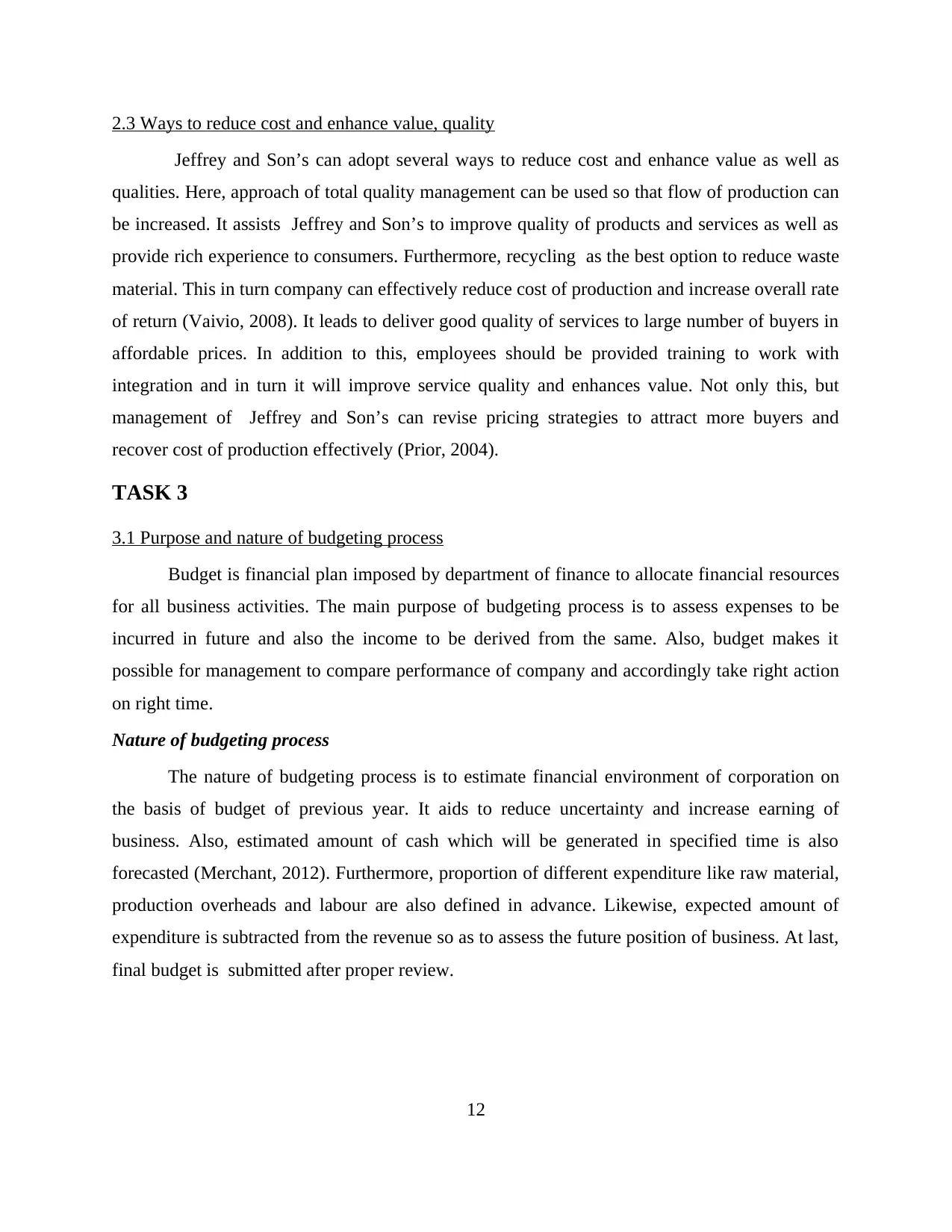
2.3 Ways to reduce cost and enhance value, quality
Jeffrey and Son’s can adopt several ways to reduce cost and enhance value as well as
qualities. Here, approach of total quality management can be used so that flow of production can
be increased. It assists Jeffrey and Son’s to improve quality of products and services as well as
provide rich experience to consumers. Furthermore, recycling as the best option to reduce waste
material. This in turn company can effectively reduce cost of production and increase overall rate
of return (Vaivio, 2008). It leads to deliver good quality of services to large number of buyers in
affordable prices. In addition to this, employees should be provided training to work with
integration and in turn it will improve service quality and enhances value. Not only this, but
management of Jeffrey and Son’s can revise pricing strategies to attract more buyers and
recover cost of production effectively (Prior, 2004).
TASK 3
3.1 Purpose and nature of budgeting process
Budget is financial plan imposed by department of finance to allocate financial resources
for all business activities. The main purpose of budgeting process is to assess expenses to be
incurred in future and also the income to be derived from the same. Also, budget makes it
possible for management to compare performance of company and accordingly take right action
on right time.
Nature of budgeting process
The nature of budgeting process is to estimate financial environment of corporation on
the basis of budget of previous year. It aids to reduce uncertainty and increase earning of
business. Also, estimated amount of cash which will be generated in specified time is also
forecasted (Merchant, 2012). Furthermore, proportion of different expenditure like raw material,
production overheads and labour are also defined in advance. Likewise, expected amount of
expenditure is subtracted from the revenue so as to assess the future position of business. At last,
final budget is submitted after proper review.
12
Jeffrey and Son’s can adopt several ways to reduce cost and enhance value as well as
qualities. Here, approach of total quality management can be used so that flow of production can
be increased. It assists Jeffrey and Son’s to improve quality of products and services as well as
provide rich experience to consumers. Furthermore, recycling as the best option to reduce waste
material. This in turn company can effectively reduce cost of production and increase overall rate
of return (Vaivio, 2008). It leads to deliver good quality of services to large number of buyers in
affordable prices. In addition to this, employees should be provided training to work with
integration and in turn it will improve service quality and enhances value. Not only this, but
management of Jeffrey and Son’s can revise pricing strategies to attract more buyers and
recover cost of production effectively (Prior, 2004).
TASK 3
3.1 Purpose and nature of budgeting process
Budget is financial plan imposed by department of finance to allocate financial resources
for all business activities. The main purpose of budgeting process is to assess expenses to be
incurred in future and also the income to be derived from the same. Also, budget makes it
possible for management to compare performance of company and accordingly take right action
on right time.
Nature of budgeting process
The nature of budgeting process is to estimate financial environment of corporation on
the basis of budget of previous year. It aids to reduce uncertainty and increase earning of
business. Also, estimated amount of cash which will be generated in specified time is also
forecasted (Merchant, 2012). Furthermore, proportion of different expenditure like raw material,
production overheads and labour are also defined in advance. Likewise, expected amount of
expenditure is subtracted from the revenue so as to assess the future position of business. At last,
final budget is submitted after proper review.
12
⊘ This is a preview!⊘
Do you want full access?
Subscribe today to unlock all pages.

Trusted by 1+ million students worldwide
1 out of 23
Related Documents
Your All-in-One AI-Powered Toolkit for Academic Success.
+13062052269
info@desklib.com
Available 24*7 on WhatsApp / Email
![[object Object]](/_next/static/media/star-bottom.7253800d.svg)
Unlock your academic potential
Copyright © 2020–2025 A2Z Services. All Rights Reserved. Developed and managed by ZUCOL.





